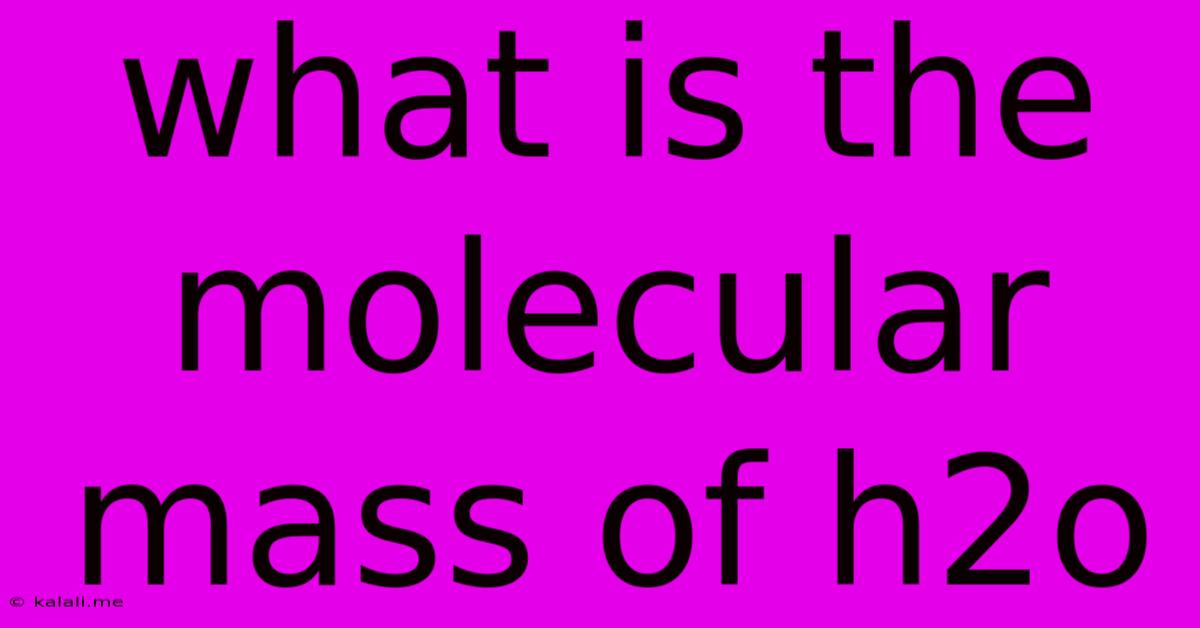What Is The Molecular Mass Of H2o
Kalali
May 10, 2025 · 2 min read

Table of Contents
What is the Molecular Mass of H₂O? A Deep Dive into Water's Weight
Water, the elixir of life, is a deceptively simple molecule with a profound impact on our world. Understanding its properties, even at the molecular level, is crucial to appreciating its significance. This article delves into the calculation of water's molecular mass, clarifying the process and explaining its importance. We'll explore the concept of molecular weight, its units, and how it relates to other crucial water properties.
Understanding Molecular Mass
The molecular mass (or molecular weight) of a substance represents the total mass of all the atoms that constitute a single molecule of that substance. It's expressed in atomic mass units (amu) or Daltons (Da). Crucially, it's different from molar mass, which represents the mass of one mole (6.022 x 10²³ particles) of a substance and is expressed in grams per mole (g/mol). While related, understanding the difference is key.
Calculating the Molecular Mass of H₂O
Water, or H₂O, consists of two hydrogen atoms (H) and one oxygen atom (O). To calculate its molecular mass, we need the atomic masses of these elements:
- Hydrogen (H): Approximately 1.008 amu
- Oxygen (O): Approximately 16.00 amu
Therefore, the molecular mass of H₂O is calculated as follows:
(2 x atomic mass of H) + (1 x atomic mass of O) = (2 x 1.008 amu) + (1 x 16.00 amu) = 18.016 amu
Therefore, the molecular mass of H₂O is approximately 18.016 amu.
Significance of Molecular Mass
The molecular mass of water isn't just a theoretical value; it has practical implications:
-
Stoichiometry: In chemical reactions, the molecular mass is essential for determining the precise quantities of reactants and products. This is crucial in various applications, from industrial chemical processes to laboratory experiments.
-
Physical Properties: The molecular mass directly influences properties like boiling point, melting point, and density. Water's relatively high boiling point, for example, is partly attributed to its hydrogen bonding and molecular mass.
-
Osmosis and Diffusion: Molecular mass plays a role in understanding processes like osmosis (movement of water across membranes) and diffusion (movement of molecules from high to low concentration).
Beyond the Basics: Isotopes and Variations
It's important to note that the atomic masses used above are average values. Elements exist as isotopes—atoms with the same number of protons but different numbers of neutrons. The slight variations in isotopic abundance can lead to minor variations in the calculated molecular mass of water. However, 18.016 amu remains a highly accurate and practical approximation for most applications.
Conclusion
The molecular mass of water, approximately 18.016 amu, is a fundamental property that underpins its behavior and crucial role in various natural processes and human applications. Understanding this seemingly simple calculation highlights the importance of basic chemistry in comprehending the world around us. From understanding chemical reactions to appreciating the unique properties of this essential molecule, the molecular mass of H₂O is a cornerstone of scientific understanding.
Latest Posts
Latest Posts
-
How Many Cups Of Chocolate Chips In 4 Oz
Jul 15, 2025
-
If Your 31 What Year Were You Born
Jul 15, 2025
-
How Many Tenths Are In An Inch
Jul 15, 2025
-
Which Word Has The Most Positive Connotation
Jul 15, 2025
-
How Do I Send An Evite Reminder
Jul 15, 2025
Related Post
Thank you for visiting our website which covers about What Is The Molecular Mass Of H2o . We hope the information provided has been useful to you. Feel free to contact us if you have any questions or need further assistance. See you next time and don't miss to bookmark.